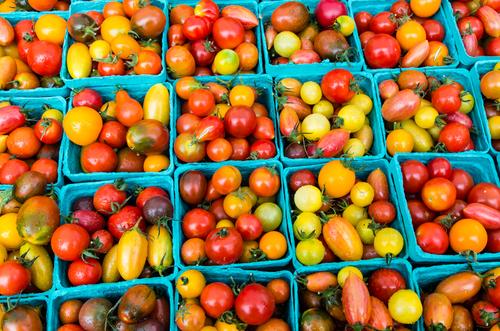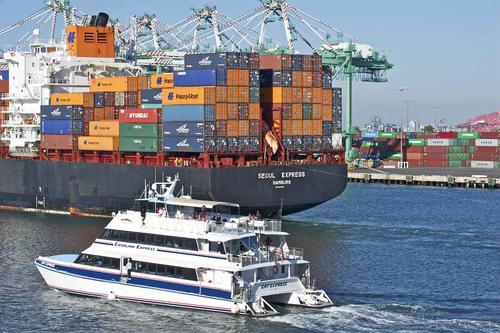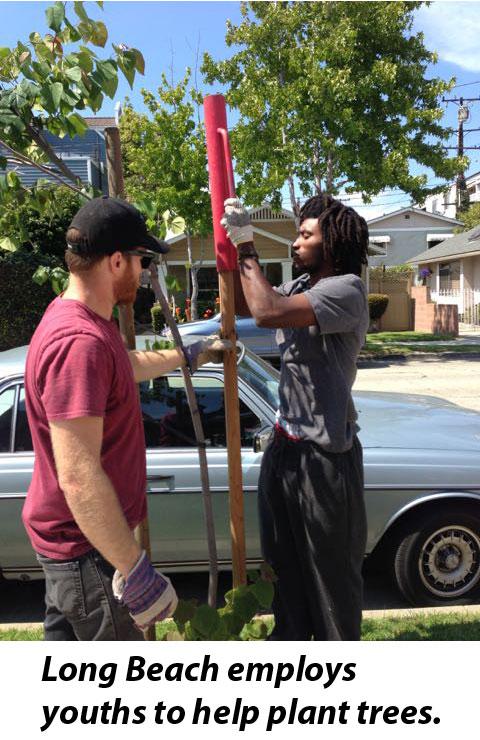Planting the Seeds for a Healthy and Vibrant Community
This article is a service of the Institute for Local Government. For more information, visit www.ca-ilg.org.
Local governments are implementing creative, innovative solutions to state-mandated goals for reducing greenhouse gas emissions. Implementing these solutions and sustainability best practices can have economic development, fiscal and health benefits for your community. For example, economic development benefits can include:
- Savings to residents and businesses through reduced expenditures on water, energy, gas and other resources that in turn are available to support additional local investments; and
- Retaining and supporting the competitiveness of small to medium-sized businesses, which are the source of most employment growth.
Keeping Jobs and Resources Local
Agriculture production and processing is a $36.5 billion industry — one of California’s largest. It encompasses over 400 commodities and accounts for nearly half of the fruits, nuts and vegetables in the nation (www.cdfa.ca.gov/statistics/). Often the communities that produce these products do not reap all the associated economic benefits.
The Sacramento Valley region’s farm gate value — the price paid to the farmer for raw products — is roughly $1.66 billion today. However, by the time that food reaches the consumer, its value has increased substantially. This is a key reason why local governments are working to keep food systems local.
In local or regional food systems food is grown, harvested and distributed near consumers’ homes and transported over shorter distances that typical food production systems. Farm products are generally processed on the farm or in small production facilities, creating local jobs and providing other benefits for the community. In local food systems farms often distribute directly to the customer or directly to the retailer (www.sustainabletable.org/254/local-regional-food-systems).
The most common direct-to-consumer distribution method is farmers markets. However, some communities engage in community supported agriculture, in which customers buy a “share” of a farm’s estimated harvest. The customers typically pay for their share in advance when they sign up for the service, which allows farmers and customers to share in both risk and reward.
These types of systems often distribute directly to retailers as well. In these instances, farmers either distribute directly to grocery stores, restaurants, schools and other institutions or they drop their products at a “food hub” where multiple farmers bring their products for distribution to retail locations. These distribution methods reduce the need for storage and transportation of farm products.
The Rural-Urban Connection
Bringing this to a large-scale operation requires collaboration with many stakeholders. The Sacramento Council of Governments (SACOG) is working with the City of Winters on a Rural-Urban Connection Strategy (RUCS). Experts are working with farmers, ranchers, agricultural researchers, farm bureaus, government officials, distributors, chefs and other stakeholders to help understand the policies, programs and infrastructure needs to create a market that would help keep locally produced products in the region. The goal of the research is to create a model where the agriculture production, processing, distribution, marketing, storage and consumption will be done more effectively and closer to home.
“We have the rock stars of agriculture that produce high quality food in a sustainable and responsible way,” says John Donlevy, Jr., city manager for the City of Winters. “We want them to be successful and benefit from all of their good work. When they make money, it’s reinvested back into our economy.”
A more streamlined process can have benefits for your local community, your neighboring jurisdictions and California as a whole. Local food systems can create jobs in your community and support local farmers. Farmers markets can generate economic benefits for the surrounding businesses by bringing in an additional customer base. The reduction in transportation needs can also generate wider environmental benefits for surrounding areas and the state.
The Bigger Picture
Food systems have broader implications and benefits for all California communities, including reduced greenhouse gas emissions, better air quality and less wear on transportation infrastructure.
Transportation is the largest generator of greenhouse gas emissions in California. The economic benefits of more efficient transportation practices include conserving fuel, reducing the health impacts of air and water pollution, reducing traffic congestion and making streets safer for pedestrians, bicyclists, transit users and motorists. In addition, reductions in greenhouse gas emissions puts California in a better position to meet state-mandated goals. AB 32 sets the ambitious goal of reducing greenhouse gas emissions to 1990 levels by 2020, finding more efficient transportation options will be a large part of meeting this goal (www.arb.ca.gov/cc/ab32/ab32.htm).
Local food systems also generate less wear and tear on expensive transportation infrastructure. California has 31,827 miles of major roads, an estimated 34 percent of which are in poor condition. This is costly to the state, local governments and residents alike. Driving on roads in poor condition is estimated to cost California motorists $17 billion a year in extra vehicle repairs and operating costs (www.infrastructurereportcard.org/california/california-overview/). Transporting goods has a large impact on California’s transportation infrastructure. Engineers estimate that big rig trucks cause more damage to a highway than 5,000 cars. This impact increases when the trucks are overloaded. When a truck’s weight is increased to 90,000 pounds (from the interstate limit of 80,000 pounds) the road wear increases by 42 percent. As a result, pavement designed to last 20 years can wear out in just seven (www.governing.com/topics/transportation-infrastructure/Too-Big-The-Road.html).
Connecting Initiatives
The area stretching from Long Beach to East Los Angeles has been labeled by some as the “diesel death zone.” Emissions from trucks, ships and trains transporting food and other materials from the ports envelop the region, causing asthma and other illnesses.
In 2006 the ports of Long Beach and Los Angeles voluntarily created and approved the San Pedro Bay Ports Clean Air Action Plan, which provides the overall strategy for dramatically reducing air pollution emissions from port-related cargo movement. In 2010 the ports updated the plan to include more aggressive goals to reduce port-related emissions. Since the plan was updated, the ports have implemented a clean-truck program that has replaced many old diesel trucks with newer models equipped with particle filters. In addition to implementing dozens of sustainable practices, the port has also created its own onsite landfill that has helped reduce traffic congestion and associated transportation emissions.
As a result of these targeted sustainability practices, the Port of Long Beach has cut diesel particulates by 81 percent since 2005. In addition, the port has reduced levels of two gases that can cause respiratory problems, nitrogen oxides and sulfur oxides, by 54 and 88 percent respectively.
The City of Long Beach works closely with the Port of Long Beach and has developed many of its own policies and programs to help offset the effects of air pollution, particularly on low-income communities. Long Beach has created a program that employs nearly one dozen young adults (many who have termed out of the foster care system) at minimum wage to help plant trees and learn about urban agriculture. These workers also help implement other elements of Long Beach’s sustainability plan such as installing drought tolerant landscaping, implementing rainwater capture systems and delivering mulch from the city’s composting efforts to the homes of residents (see ”Operation Mulch-a-Lot: Long Beach Chips Away at Blight and Green Waste“). Long Beach Mayor Robert Garcia’s vision is to have hundreds of young adults working in this way.
“The No. 1 tool to support economic development is education,” says Mayor Garcia. “That’s why providing meaningful work experience and green job training opportunities for youth is so important for the city. I’m proud of the work we’re doing to pave the way for a more sustainable future in Long Beach.”
Conclusion
These examples illustrate how implementing sustainability practices can have many co-benefits for your community. These benefits can include job creation, environmental and fiscal benefits. To learn more about economic development benefits of implementing sustainability best practices and what local government across the state are doing, see ILG’s publication Prosperity that Lasts: Building Economically Sustainable Communities.
Related Resources
Engaging the Public in Economic Development
Sustainable Economic Development Resource Center
SACOG’s Sacramento Region Food Hub Analysis
Photo credits: Zigzag Mountain Art/Shutterstock.com (farmers market); Jonson/Shutterstock.com (truck); Philip Pilosian/Shutterstock.com (ship); Courtesy of City of Long Beach (youths planting trees)
This article appears in the May 2015 issue of Western City
Did you like what you read here? Subscribe
to Western City





